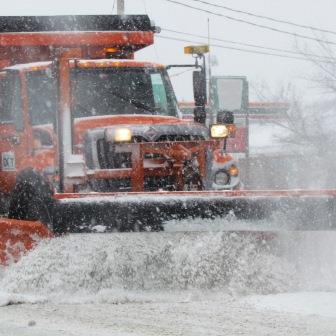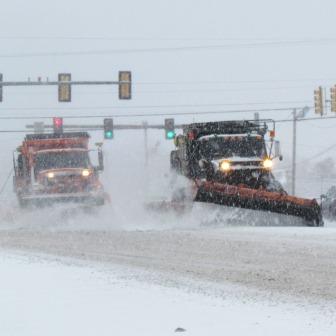
Snowplow accidents happen. They may be rare but they do happen.
When the snow flies we all rely heavily on snow plows to clear and treat the roads. As the white stuff piles up, snow plows barrel through to keep highways and byways from becoming impassable. Plow truck drivers face poor conditions in their job to keep the roads safe and open.
Despite cautions by authorities to “Stay clear of the plow” and “Don’t crowd the plow” accidents during snow and ice storms are far from uncommon. National statistics track hundreds of snowplow accidents every winter.
Snowplow accidents, happening in the worst of conditions, can shut down highways and cause serious injuries or fatalities.
Why Snowplow Accidents Happen
While they are working most snowplows operate at a speed in the range of 35 miles per hour. That’s about the top speed the equipment tolerates while plowing optimally and maintaining safety. Drivers tempted to pass snowplows fail to understand that road is always in the best condition behind the plow. The plow exists because the roadway ahead is in poor condition.
The imposing size of snow plow trucks makes it extremely difficult to see around them to determine if it is clear and safe to pass. Impatient motorists who risk it and attempt to go around the plow often run up against hazards including oncoming vehicles, icy roads or other snow plows in neighboring lanes. Passing the plow puts all surrounding motorists’ lives at risk for injuries, death, and damages.
Passing a snow plow is never a good idea. But if absolutely necessary pass as quickly as possible while providing plenty of room between vehicles. Often when drivers pass plows, they quickly move out of the passing lane in poor conditions, cutting directly in front of the plow truck. This causes accidents because the driver fails to account for how far from the front the plow protrudes, and the driver may “clip” or swipe the plow. When this occurs, the driver will likely get caught in the plow, lose control, and may get pushed off the road, or into another lane containing traffic in which another accident could likely result.
Highway officials highly recommended that drivers pass plows only on the left, if at all. The large plow on the front of the truck often has a large overhang on the right into the neighboring lane, so when a driver attempts to pass a plow on the right, chances are good they’ll clipping the blade. Not a good idea.
Behind snow plows roadways are treated and this is the recommended spot where all vehicles should remain. At the same time, following the snow plow truck too closely poses great danger. Snow plow tailgaters find themselves getting hit by snow, ice and debris. If following too closely, such substances obstruct driver view, or jam up in tires and cause accidents.
Also due to the size of plow trucks, vehicles traveling closely behind the plow can’t see potential hazards ahead such as traffic or accidents. So, the driver behind the plow has no warning that the plow may come to a stop, which may cause the vehicle to rear-end the plow. It is highly recommended that all drivers keep a distance of at least 3 car lengths behind snow plows and reduce speed.
The View of the Snow Plow Operator
Plow truck operators require space to have the ability to go around vehicles that are stuck on the side of the road or pulled over. If the plow truck becomes blocked in, the operator may cause a hazard to the driver and passengers on the side of the road because the plow truck operator may not be able to stop in time due to the size and weight of the vehicle combined with poor road conditions that will likely cause the vehicle to slide. Therefore, if a quick stop is required, plow truck operators heavily rely on escape routes or backup plans opposed to slamming on the brakes, which is why it is so necessary that all drivers provide the plow truck operator with plenty of room, or never trap them while passing.
Often snow plow accidents happen because the trucks are in areas and lanes where everyday motorists do not expect them. Aside from travel lanes, plow trucks are responsible for clearing break-down lanes, shoulders, parking lots, and ramps. Drivers do not predict to see plow trucks in these areas and may be surprised when they come up on the plow quickly in low visibility conditions. If and when the motorist sees the plow, it may be too late and they could panic or be in too close of proximity to avoid a collision with the plow.
Major Causes of Snow Plow Accidents
Staying clear of snow plows seems obvious. Here are the top reasons snow plow accidents happen:
- Low visibility from poor weather conditions
- Intoxicated or impaired operators
- Inattention from motorists and pedestrians
- Hazards caused by poor weather
- Slippery or untreated roadways
- Reckless driving
- Speeding
There are many causes for plow truck accidents. Some accidents are caused by the plow truck driver, but most are due to another driver’s error combined with road conditions.
When the Plow is at Fault

Plow truck drivers make mistakes just like any other motorist, but due to the weight of their vehicles and the equipment attached, the vehicle that collides with the plow truck often becomes seriously injured, if not killed. Although motorists are most often at fault for accidents involving snow plow vehicles, snow plow operators have been known to cause accidents for a variety of reasons, such as:
- Drowsy or Fatigued Operator
- Low Visibility
- Distracted Driving
- Intoxicated Driving
- Insufficient Training
- Driver Inexperience
- Faulty Equipment
Plow truck drivers often work long shifts that often fall on the early hours of the day. Due to the lengthy and strenuous shifts, plow truck drivers can become drowsy and inattentive behind the wheel, which could lead to a collision. If the driver is bored or trying to stay awake, plow truck operators may engage with distractions just like any other driver, which could cause them to lose control of the vehicle and crash.
To minimize the risk of a collision and ensure due care is practiced, plow truck owners have a duty to properly maintain their equipment, complete inspections, not over-work the employees, and properly train their employees. Whereas, the operators of the plow trucks have a duty of reasonable care such as all other drivers on the roads, but held to a higher standard since driving is their profession.
Accidents do happen, equipment does malfunction, and plows often spark while being pushed along the road, so it is best to take extra precautions to keep you safe. You must always be sure you can see oncoming traffic and have sufficient visibility before attempting to pass a snow plow. Keep in mind that plow trucks are often extremely tall compared to the average vehicle, so you cannot rely or assume that the plow truck driver sees you.
Aside from the height of the truck, plow truck drivers most frequently operate in poor weather conditions that reduce visibility significantly, and reduced visibility is the leading cause of plow truck accidents. To assist the plow truck operator and all other vehicles on the road, always have your headlights turned on when the weather conditions are poor. Beyond using headlights, make sure your entire vehicle is cleared off. If snow or ice covers your vehicle, it could prevent other drivers from seeing your vehicle and lights, and you risk the snow and ice blowing off and landing on another vehicle obstructing their view, and causing an accident.
The bottom line: Poor conditions bring out the snow plows. Poor visibility caused by falling or drifting snow greatly reduces a driver’s ability to see other vehicles and people. If impossible to avoid driving during bad weather, allow plenty of space between your vehicle and snow plows, and resist the urge to maneuver dangerously around plow trucks.
In a related article we address the question of whether you can sue a city or town for failing to remove snow and ice properly. https://attorney-myers.com/2015/02/sue-city-snow/
Visits: 264





One thought on “Snow Plow Accidents: Why They Happen”